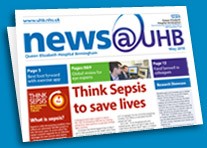Your views

Your feedback is vital to us as we continue to increase the quality of our services.
You are here:
Date: 19 November 2024
Time: 23:42
Respiratory treatment cuts mortality rate
Story posted/last updated: 29 November 2012
Queen Elizabeth Hospital Birmingham (QEHB) has been praised in a national report following its success in treating patients with respiratory failure.
The British Thoracic Society has produced a national audit involving the use of Non Invasive Ventilation (NIV) outside of intensive care units.
Its results show that the service at QEHB has outperformed the national average in nearly all the key areas, in particular treatment success and low mortality rates.
The second annual audit centred on the use of NIV in the management of patients admitted to hospital with acute type 2 respiratory failure.
It revealed that QEHB achieved a treatment success rate of 81.8 per cent, compared to the national average of 67.7 per cent.
At the same time, only 2 out of 22 QEHB patients observed during the study in February and March this year subsequently died. This gave a mortality rate of 9 per cent, which was more than three times lower than the national figure of 30 per cent.
Dr Shyam Madathil, Consultant Physician in Respiratory Medicine at University Hospitals Birmingham NHS Foundation Trust (UHB), said: “The results show that the service at QEHB has performed exceptionally well and it outperforms the national average on nearly all key performance indicators.
“We have scored especially well in the parameters of documenting treatment plans, early senior medical involvement in decision making, treatment success and low mortality rate.
“I believe this is due to a combination of factors including appropriate patient selection, hard work from the NIV physiotherapists, ward nursing staff, and strong respiratory consultant input.”
Dr Madathil said many patients with chronic obstructive pulmonary disease (COPD) with acute respiratory failure would previously be admitted into intensive care, but the development of ward-based ventilation masks meant this was no longer the case in most instances.
“It also means the treatment is non invasive, so the patient is awake and can take the ventilator off and eat and drink between times. This is much better for the patient.
“This service was started in the Trust about three years ago and has grown in numbers from around 100 patients last year to 140 now. We now hope to expand the service so we can treat more patients, other than those with COPD.
“Compared with the national audit, we have done extremely well on almost every count, which we are very pleased about. Obviously, the key ones are low mortality and the success rate. Success is preventing death and avoiding using invasive ventilation in intensive care."
The national audit involved a total of 2,187 patients in 122 institutions across the country. The report said QEHB produced a “good performance overall” compared with national results.

Getting here
Information about travelling to, staying at and getting around the hospital.

Jobs at UHB
A great place to work. Learn why.
news@UHB


RSS feed
Subscribe to our news feed


